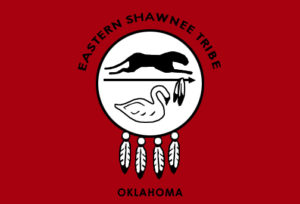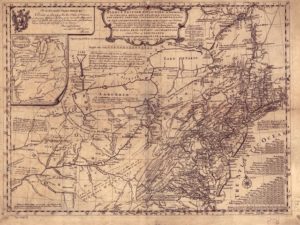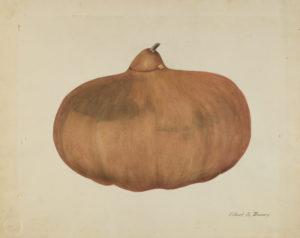Fighting back wasn’t the Shawnees’ only strategy to maintain access to salt resources. In the summer of 1783, a group of Shawnee hunters convened with three Kentucky settlers south of the Ohio to trade. The Shawnees requested “licker and sault,” and the American traders reportedly secured assurance from a nearby militia commander that traders would soon bring salt to Shawnee towns. Treaties also became another means of negotiation over salt. In the 1803 Treaty of Fort Wayne, Indigenous leaders ceded control over the Grand Saline at the mouth of the Wabash River to the U.S. government. Their price was an annual annuity of 150 bushels of salt that would “be divided among the several tribes in such manner as the general council of the chiefs may determine.”
The few histories of salt in the Ohio Country often start and end with American industry. In these narratives, Shawnees and other Indigenous peoples are treated as peoples without a past or future. But as Susan Sleeper-Smith has recently shown, Indigenous prosperity in the Ohio Country offers critical precedent for the trajectory of American expansion into the region and, more significantly, Indigenous peoples’ ability to retain access to vital spaces, resources, and networks. Indeed, early American salt makers exploited productive precedents established by generations of people who had engaged with salt resources for thousands of years. This deeper history of salt shaped space, relations, and power dynamics during the eighteenth century in ways both explicit and obscure.
As the tumultuous salvation of the Shawnees’ Go-cum-tha and her Wash-et-che reminds us, salt’s ability to invite both creation and destruction to the heart of Shawnee homelands was hardly contradictory and hardly ancient history. That great salt water that drowned and drained the region’s lands long ago remained just as powerful and potent generations later, emerging in the form of brine seeps, mineral springs, and salt licks that helped to orient life across the Ohio Country.
Further Reading
George Bluejacket, “A Story of the Shawanoes,” recorded at Wapaughkonnetta, Ohio (October 29, 1829); trans. and ed. John Allen Rayner (March 1886), via Kansas Memory, https://www.kansasmemory.org/item/210156/.
Stephen Warren, The Worlds the Shawnees Made: Migration and Violence in Early America (Chapel Hill: The University of North Carolina Press, 2014).
Harriette Simpson Arnow, Seedtime on the Cumberland: Life in the Cumberland River Region of Kentucky and Tennessee, 1780-1803 (New York, NY: Macmillan, 1960).
Eric J. Wallace, “Making Salt From an Ancient Ocean Trapped Below the Appalachians,” Atlas Obscura, Jan. 8, 2018.
Honor Sachs, Home Rule: Households, Manhood, and National Expansion on the Eighteenth-Century Kentucky Frontier (New Haven: Yale University Press, 2015), esp. ch. 2.
Ian W. Brown, Salt and the Eastern North American Indian: An Archaeological Study (Cambridge, MA: Harvard Univ. Peabody Museum, 1980).
Thomas D. Clark, “Salt, a Factor in the Settlement of Kentucky,” Filson Historical Society Archives, May 3, 1937.
Paul N. Eubanks and Ian W. Brown, “Certain Trends in Eastern Woodlands Salt Production Technology,” Midcontinental Journal of Archaeology 40, No. 3 (2015).
James L. Murphy, “Above the Salt: Test Excavations at the Scioto Saline, Jackson County, Ohio,” Ohio Archaeologist 54, No. 2 (2004): 38-42
Stanley Hedeen, Big Bone Lick: The Cradle of American Paleontology (Lexington, KY: University Press of Kentucky, 2008).
Kenneth B. Tankersley, Michael R. Waters, and Thomas W. Stafford Jr., “Clovis and the American Mastodon at Big Bone Lick, Kentucky,” American Antiquity 74, No. 3 (2009): 558-67.
Walter Fewkes, John R. Swanton, and William Edward Myer, Forty-Second Annual Report of the Bureau of American Ethnology, 1924-1925 (Washington, DC: Smithsonian Institution, 1925).
John A. Jakle, “The American Bison and the Human Occupation of the Ohio Valley,” Proceedings of the American Philosophical Society 112, No. 4 (1968): 299-305.
Susan Sleeper-Smith, Indigenous Prosperity and American Conquest: Indian Women of the Ohio River Valley, 1690-1792 (Chapel Hill: The University of North Carolina Press, 2018).
Gwynn Henderson, “The Lower Shawnee Town on the Ohio: Sustaining Native Autonomy in an Indian ‘Republic,’” in The Buzzel about Kentuck: Settling the Promise Land, ed. Craig Thompson Friend (Lexington, KY: University Press of Kentucky, 1999), 25-55.
Gwynn Henderson, “Dispelling the Myth: Seventeenth- and Eighteenth-Century Indian Life in Kentucky,” Register of the Kentucky Historical Society 90, No. 1 (1992): 1-25.
James Duvall, ed., Early Documents relating to Mary Ingles and the Escape from Big Bone Lick, (Burlington, KY: Boone County Public Library, 2008).
John Mack Faragher, Daniel Boone: The Life and Legend of an American Pioneer (New York, NY: Henry Holt and Company, 1992).
H. Bogart, Daniel Boone and the Hunters of Kentucky (Philadelphia, PA: J. B. Lippincott and Co., 1881).
Isaac Lippincott, “The Early Salt Trade of the Ohio Valley,” Journal of Political Economy 20, No. 10 (1912): 1029-52.
Robert E. McDowell, “Bullitt’s Lick: The Related Saltworks and Settlement,” Filson Club History Quarterly 30, No. 3 (1956).
John A. Jakle, “Salt on the Ohio Valley Frontier, 1770-1820,” Annals of the Association of American Geographers 59 (Dec. 1969): 687-709.
Reuben Gold Thwaites, Early Wester Travels, 1748-1846, 5 vols. (Cleveland, OH: The A. H. Clark Company, 1904-1907).
Reuben Gold Thwaites and Louise Phelps Kellogg, eds., Documentary History of Dunmore’s War, 1774 (Madison, WI: Democrat Printing Company, 1908).
Reuben Gold Thwaites and Louise Phelps Kellogg, eds., Frontier Defense on the Upper Ohio, 1777-1778, Draper Series vol. 3 (Madison, WI: Wisconsin Historical Society, 1912).
Richard Collins, Collins’ Historical Sketches of Kentucky: History of Kentucky, ed. Lewis Collins, vol. 2 (Covington, KY: Collins & Co., 1874).
Rob Harper, Unsettling the West: Violence and State Building in the Ohio Valley (Philadelphia: University of Pennsylvania Press, 2018).
“Treaty of Fort Wayne,” Kansas Kickapoo Tribe, https://www.ktik-nsn.gov/history/treaties/1803-treaty/.
This article originally appeared in January 2022.
Annabel LaBrecque is a Ph.D. student in the Department of History at University of California, Berkeley. Her work explores interdisciplinary approaches to the significance of salt throughout North American history. She has previously published research on salt and power in the sixteenth-century Lower Mississippi Valley for the Scottish Centre for Global History.




